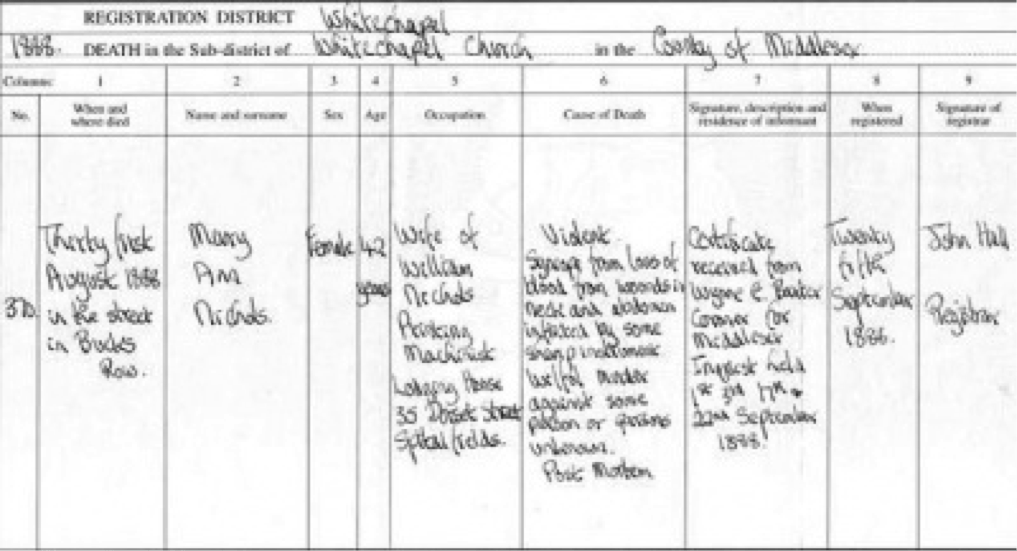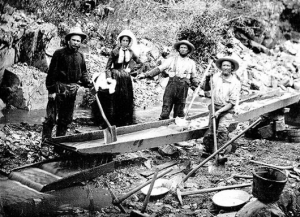Born on August 26, 1845 in London England, Mary Ann Walker was raised by locksmith Edward Walker and his wife Caroline. She married William Nichols, a printer’s machinist, in 1864; however, the couple divorced due to Mary’s drinking habits and prostitution allegations. Mary, now Mary Anne Nichols, continued practicing prostitution and was known for moving between workhouses and boarding houses, and living off charitable donations.

Prostitutes in Europe were regarded with mixed feelings in the nineteenth century. An awareness for the vulnerability of women prostitutes was fairly low and they were treated with curiosity as well as disgust. They had few economic options for making their way in the world and the women themselves were generally born into poverty and had little education or work skills. London prostitutes, especially those who operated on the streets, regularly picked the pockets of the men they preyed on. They kept an eye out for drunkards, from whom they could steal without the risk of being caught. However, this wasn’t the case with Mary as she herself spent most of her waking hours under the influence. Prostitution was very much frowned upon in London, and the women engaging in the profession were seen as the lowest of the low. It wasn’t unusual for men to beat and kill a prostitute after a ‘session,’ so when Mary Ann was found dead with her skirt lifted above her stomach, it was nothing out of the ordinary.1
The night in question was August 30, 1888. A heavy rain was falling on London during one of the coldest and wettest summers on record. Mary Ann was last seen walking down Whitechapel Road, and more than likely she was there soliciting her trade. Prostitution was a very dangerous profession one hundred thirty years ago. With no proper policing and the women themselves looked upon as animals, people would do with them as they pleased. No wonder the infamous ‘Jack the Ripper’s’ victims were all prostitutes.2 They were easy targets, and he was able to get away with murder.
Nichols was often found in the lodging house on 18 Thrawl Street; however, on this specific night she was knocked back due to a lack of money.3 Mary wasn’t fazed by this though, and was on her way back to her ‘office,’ the streets. At 2:30 am she ran into Emily Holland, another worker, who described Mary to be drunk and staggered against a wall. She told Emily that she was off to find another ‘punter’ in an attempt to get her ‘doss’ money in order to rest her head that night.4 One can’t help but think that Mary was selected by Jack because of her drunkenness and through no fault of her own she was destined to a brutal ending because she was such an easy victim. Emily Holland was the last known person to interact with Mary, and only one hour later, at 3:40 am, the latter was found cold and lifeless on the side of Bucks Row, a mere ten minutes walk from where the interaction took place.5

Constable Thain and Sergeant Kerby both passed down Bucks Row at 3:15, but reported nothing out of the ordinary. One must wonder what Nichols was doing from 2:30 to 3:40. She was only ten minutes away from Bucks Row, yet was found dead there seventy minutes later. Another thought would be: what was Jack the Ripper doing during that time. 6
Nichols’ body was initially found by two workmen, who both decided to leave her lying, as they didn’t want to be late for work. However, they let a police officer know her whereabouts on their way. Major bruising was found on Mary’s body and five of her teeth were missing. Investigators put this down to the struggle. Nevertheless, there were several deep cuts along her abdomen, which shows that her attacker enjoyed closeness with his victim, whom he supposedly raped and then mutilated. One can only speculate on why these cuts were made as they were, in no pattern, and didn’t relate to anything. As the first kill, maybe Jack was experimenting with Mary, and she was some sort of sick puppet in which his fantasies could be played out.7

Mary was buried on Thursday, September 6 of that year in the City of London’s Cemetery.8 Two days later, another of Jack’s victims, Annie Chapman, was found in the back garden of a London flat.9 Her womb had been removed and her body left horrifically mutilated. Jack the Ripper had indeed struck a second time. He wasted no time in preparing his second victim, yet this time it was more brutal than the first. One may wonder if Jack had attempted to remove Mary’s womb, but was perhaps disturbed and fled the scene before he could complete the operation.10 Jack the Ripper’s third victim was Elizabeth Stride. She was found at 1:00 am in Dutfield’s Yard, London. The fact that her throat had been cut, but the rest of her body had not been touched, led to speculation that her killer had been interrupted. This links with Mary Ann’s case because it is believed that Jack was also interrupted while working on her. One may believe that Jack liked the excitement of being caught, as he seemed to carry out his kills in the middle of streets. The fourth victim was found in Mitre Square in the City of London at 1:45 am. Catherine Eddowes was savagely mutilated by The Ripper, as her face was torn off and her uterus was missing along with her kidney. Clearly, Jack had not been interrupted this time. On November 9, the body of Mary Kelly was found in her room in Miller’s Court at 10:45 am. She had been virtually skinned to the bone and many experts believed that she was Jack the Ripper’s final victim. This was a fitting finale for the sick monster, as he chose a private area in order to carry out his most disturbing kill of all.11
For well over one hundred years since the time of the murder of Mary Ann and the rest of Jack’s victims, the identity of the killer has been regularly questioned, with nearly one hundred suspects having been named in the process. While many theories exist, none of them have proven to be indisputably convincing. Many think the Ripper was a commoner, possibly a butcher or other tradesman, who lived locally and was employed during the week, explaining why the murders occurred on or near the weekend. A lot of experts also agree that the Ripper was a local to Whitechapel. One of the most compelling suspects was Thomas Hayne Cutbush, who was a violent youth diagnosed insane at the time of the murders in 1888, and was believed to be wandering the streets of London throughout the time of the killings. Subsequently, the murders then stopped after Cutbush was locked up. Disappointingly, this information, along with more evidence, did not prove that Cutbush and Jack the Ripper were the same man; but there was enough evidence to keep Cutbush on the suspect list.12
The finger of suspicion was first pointed at Cutbush in 1894, by The Sun newspaper.13 The article claimed that despite the popular theory of the Ripper being dead, he was in fact a mental patient. The Sun’s detailed description clearly resembled that of Cutbush. The suspicion was that the Metropolitan Police covered up his guilt to avoid the embarrassing outcry that would have followed if the country’s most feared serial killer was found to be Superintendent Henry Cutbush’s nephew. Henry was a high ranked officer, whose reputation could have been seriously damaged if his relative was found to be Jack the Ripper. This is another reason why Thomas Cutbush was actively considered as a suspect.
Some named Cutbush as the No 1 Ripper suspect, but others have strongly denied this theory. Its main weakness is that the last known Ripper victim died in November 1888, at the end of the eleven week killing spree. If Cutbush was the killer, it seems odd that he would commit five murders over such short a period of time, stop for more than two years, and then commit one more assault, in which his victim survived. But there is almost no chance that the case will ever be solved. Thomas Hayne Cutbush remains top of the suspect list.14
It’s an eerie thought that this case will never be solved and even if it is, there is no one to suffer the consequences. It’s even scarier to think that there may currently still be serial killers on the run now that will also never be found and charged for their crimes. There will never be any justice for Jack the Rippers victims, but they can be certain they will never be forgotten.
- Mary Spongberg, The Body of the Female Prostitute in the Nineteenth-Century (New York, NY: New York University Press, 1997), 83-85. ↵
- Encyclopaedia Britannica, July 1998, s.v, “Jack the Ripper, English Murderer,” by John Phillip Jenkins. ↵
- Knocked back means dismissed. ↵
- A punter is a client. Doss is rent. ↵
- Stephen P. Ryder, “Casebook Jack the Ripper,” Victims: Last Addresses, August 14, 2009, 2, www.casebook.org/victims/polly.html. ↵
- Stephen P. Ryder, “Casebook Jack the Ripper.” Victims: Last Addresses, August 14, 2009, 2, www.casebook.org/victims/polly.html. ↵
- Salem Press Encyclopedia, January 2016, s.v. “Jack the Ripper,” by Cait Caffrey. ↵
- Death Certificate: no.370. 25 September, 1888. http://www.casebook.org/victims/polly.html ↵
- A back garden is a backyard. ↵
- William D. Rubenstien, “The Hunt For Jack the Ripper,” Ripper Diaries, (May 2000): 1-3. ↵
- Richard Jones, “Jack The Ripper 1888,” Victims (13 March 2016): 3. ↵
- Andy McSmith, “Madman’s notes throw new light on Ripper case,” The Independent article London, (19 November 2008). ↵
- A tabloid newspaper published in the United Kingdom and Ireland. ↵
- Richard Wheatsone, “Ripping Discovery,” The Sun (16 September 2017). ↵



211 comments
Nathan Hartley
I knew who Jack the Ripper was from TV and from movies, however he is never explained as well as he was in this article. It’s sad, but in most Hollywood portrayals of him, they never show just how terrible of a person he truly was. I think it is even sadder that these people and their families never got the justice they deserved.
Lynsey Mott
Jack the Ripper, to me I think is the most common name that comes up when you say serial killer. Its interesting to read how many people he killed and what he did to the bodies. Its really sad to see what a human being can do to another human being. Especially with Mary Kelly and how he took all of her skin, I wonder how long she lasted until she actually died, how long did she suffer, because I honestly wouldn’t last long if someone did that to me. I wonder if the guy who did it, not saying it was Thomas Hayne Cutbush, felt remorse for the suffering he caused.
Lynsey Mott
Jack the Ripper, to me I think is the most common name that comes up when you say serial killer. Its interesting to read how many people he killed and what he did to the bodies. Its really sad to see what a human being can do to another human being. Especially with Mary Kelly and how he took all of her skin, I wonder how long she lasted until she actually died, how long did she suffer, because I honestly wouldn’t
John Smith
It’s horrific what Jack The Ripper did to those women, going as far to rip out their womb and even skinning one. It makes you wonder what kind of man could have done that, but I suppose that something we’ll all never know. I can only wish that those women died before Jack The Ripper had his way with them.
Daniela Cardona
I have heard the name Jack the Ripper before, but never knew much about his actual crimes. It’s almost impossible to wrap your head around the idea that someone thought this was normal or take joy out of mutilating bodies like the Ripper did. It’s unfathomable to even think about the image of a skinned body laying in the streets. Moreover, the fact all these murders will never be solved, and all these families will never be given justice is saddening. The lengths having connections in high place will take you, even at that time, is baffling.
Mason Meza
Jack the Ripper was and still is an infamous serial killer, and almost everybody knows about him. What i did not know is how he committed the crimes and how gruesome they were. To skin a body after killing it, that is just sick. I never understood how one had the capacity to commit murder and not suffer about what they did to someone.
Daniela Duran
It is always shocking to read stories about brutal crimes as this one, especially when you come to realize that none of this is simply fiction. Many people would argue that the blame is on the victims because they were somehow exposed and “vulnerable” ; nevertheless, as the author mentions, many of these women were not only victims of the Ripper himself, but also of poverty. It would be unfair to blame them, because it was clearly their lack of opportunities in life and their lack of education what led to them finding themselves in that position. I believe a crime like this is specially cruel when the victims are vulnerable, not because of their own fault, but because of their social and economic situation. Still, Jack the Ripper is clearly guilty for everything he did, and his crimes were horribly devastating. I agree with the author that the worst of all was the one in which he removed the flesh of his victim entirely, but I also think it is terrifying how he constantly removed the womb of his victims. I was shocked by how the author said that maybe he found pleasure and excitement in feeling he was going to be discovered, because this simply implies that he was even more mentally unstable than we would think. This was a very well structured and interesting article.
Avery Looney
I like how the author took a different approach with this article. Most articles about serial killers go into great detail about the murderer’s background and the reason why the committed the crimes. The author in this article begins by talking about the first victim, Mary Ann Nichols, and her background and then addresses more of Jack the Rippers victims. It was a very interesting article to read. Jack the Ripper will always be one of the most famous serial killers ever, and it’s heartbreaking that he was never caught for his despicable crimes and that his many victims will never get justice.
Pamela Callahan
I find it hard to believe that one person could have committed 5 gruesome crimes, such as the ones listed in the article, over eleven weeks and not be apprehended. It must have taken a lot for the killer to remain in hiding for that long. The acts pulled off by the Ripper were horrific and I can’t imagine what would drive someone to do such horrible things to innocent people. I wish that justice could have been provided for the victims and I think this story serves as an example today as to why we need to capture those who will endanger the rest of society.
Diego Aguilera
I really enjoyed this article and the imagery used by the author as it kept me interested and wanting to read more stories. I knew a little about the serial killer Jack the Ripper was, it was crazy the stuff he would do. The worst thing is seeing that this man Jack the Ripper would like to see people suffer and to see no justice for the victims who were so innocent is crazy. I never understood why serial killers become serial killers so that always something to look into more.